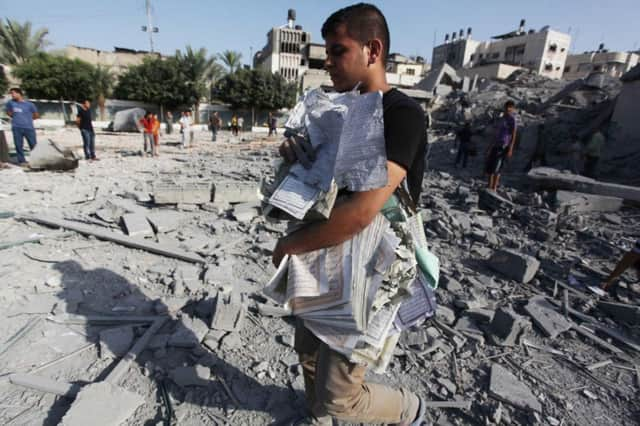Israel directs shelling at border town


The Israeli military has said it believes the soldier was grabbed by Hamas fighters about an hour after an internationally brokered ceasefire took effect on Friday morning.
The Hamas military wing yesterday distanced itself from the capture, which has prompted widespread international condemnation.
Advertisement
Hide AdAdvertisement
Hide AdIsraeli Defence Force (IDF) Second Lieutenant Hadar Goldin, 23, was reportedly dragged into a tunnel which Hamas used to cross the heavily patrolled border to carry out attacks inside Israel.
US President Barack Obama, UN secretary-general Ban Ki-moon and others accused Hamas of violating the ceasefire and have called for the soldier’s immediate release.
At least 35 Palestinians were killed in the bombardment and shelling in and around Rafah early yesterday, said Palestinian health official Ashraf al-Kidra, adding that the area’s main hospital was evacuated because of the air strikes, which killed dozens of people on Friday.
Elsewhere in Gaza, Palestinian officials reported more than 150 air strikes including one against the Hamas-linked Islamic University in Gaza City. Heavy shelling continued along the border.
The IDF claimed the university housed a “weapons development centre” and that five mosques containing Hamas command and training facilities had also been targeted.
The Hamas military wing said on its website that it is “not aware until this moment of a missing soldier or his whereabouts or the circumstances of his disappearance”.
The group said it believes the soldier might have been killed in a clash with Hamas fighters about an hour before the start of the 8am ceasefire, and that it had lost contact with some of its own men.
Hamas could be withholding information about the soldier in order to extract concessions from Israel, a strategy used by the Lebanese Hezbollah group, which did not disclose whether two Israeli soldiers it seized in 2006 were alive or dead until their remains were handed over in a prisoner exchange.
Advertisement
Hide AdAdvertisement
Hide AdIsrael has gone to great lengths to retrieve captured personnel.
In 2011, it traded 1,027 Palestinian prisoners for one Israeli soldier, tank gunner Gilad Shalit, 25, who had been captured by Hamas-allied militants in 2006.
The released prisoners were responsible for the deaths of more than 550 Israeli civilians.
The two sides would have been due to meet in Cairo yesterday but Israel last night said it had not sent the envoys, with one official saying “Hamas is not interested in an accommodation”.
Earlier yesterday, Egyptian president Abdul Fattah al-Sisi insisted a ceasefire plan offered a “real chance” to end the bloodshed.
Since fighting began on 8 July, more than 1,650 Palestinians – mostly civilians – have been killed and more than 8,000 wounded, according to Kidra. Israel has lost 63 soldiers and three civilians, its highest death toll since the 2006 Lebanon war.